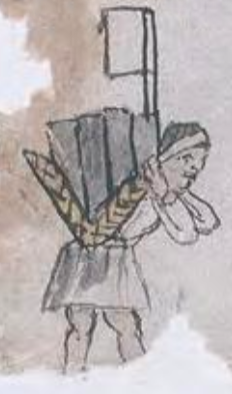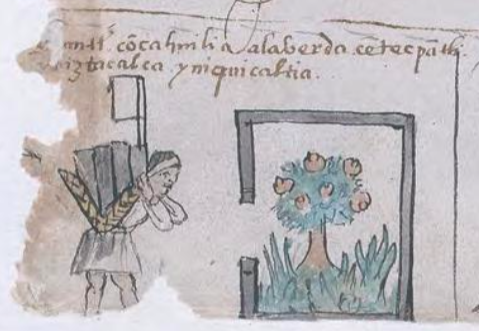centecpantli (Osu12v)
This simplex glyph and notation for a group of twenty (centecpantli) comes from the Codex Osuna, folio 12 verso (or Image 27). The number is indicated by a white flag flying toward the viewer’s left. The flag may be paper or perhaps cloth, and it is on a vertical post, probably wooden. The word flag contains “pan,” which provides the phonetic indicator that this is some number of twenties (-pantli). Here, the flag represents twenty Nahua workers from Iztacalco, who were carrying adobe (xamitl) bricks for use in constructing a house, involving the verb, quicaltia (he makes a building or a house). The Nahua man who is carrying the adobes is shown in profile facing the viewer’s right. A tumpline goes over his forehead. It must attach to the petlatl (or petate, woven mat, in Spanish), with its characteristic herringbone weave, which cradles the adobe. What we might call a tlamama (in Nahuatl) or a tameme (in Spanish, meaning a carrier, wears what appears to be a white, belted, cotton tunic.
Stephanie Wood
For more on the interpretation of this contextualizing scene from the Codex Osuna, see the work of Vicenta Cortés Alonso, Pintura del Gobernador, Alcaldes, y Regidores de México (1976), p. 474.
Stephanie Wood
1551–1565
Jeff Haskett-Wood
veinte, números, cargar, cargas, adobes, banderas, tamemes, mecapalli, mecapal, mecapales, ixcuamama, tlamama, tecnología

centecpan(tli), one group of twenty, https://nahuatl.wired-humanities.org/content/centecpantli
-tecpan(tli), a multiplier of twenty, affected by the prefixed number, https://nahuatl.wired-humanities.org/content/tecpantli
un grupo de veinte [tamemes]
Stephanie Wood
Library of Congress Online Catalog and the World Digital Library, Osuna Codex, or Painting of the Governor, Mayors, and Rulers of Mexico (Pintura del Gobernador, Alcaldes y Regidores de México), https://www.loc.gov/resource/gdcwdl.wdl_07324/. The original is located in the Biblioteca Nacional de España.
"The Library of Congress is unaware of any copyright or other restrictions in the World Digital Library Collection. Absent any such restrictions, these materials are free to use and reuse." But please cite the Biblioteca Nacional de España and this Visual Lexicon of Aztec Hieroglyphs if you use any of these images here or refer to the content on this page, providing the URL.



